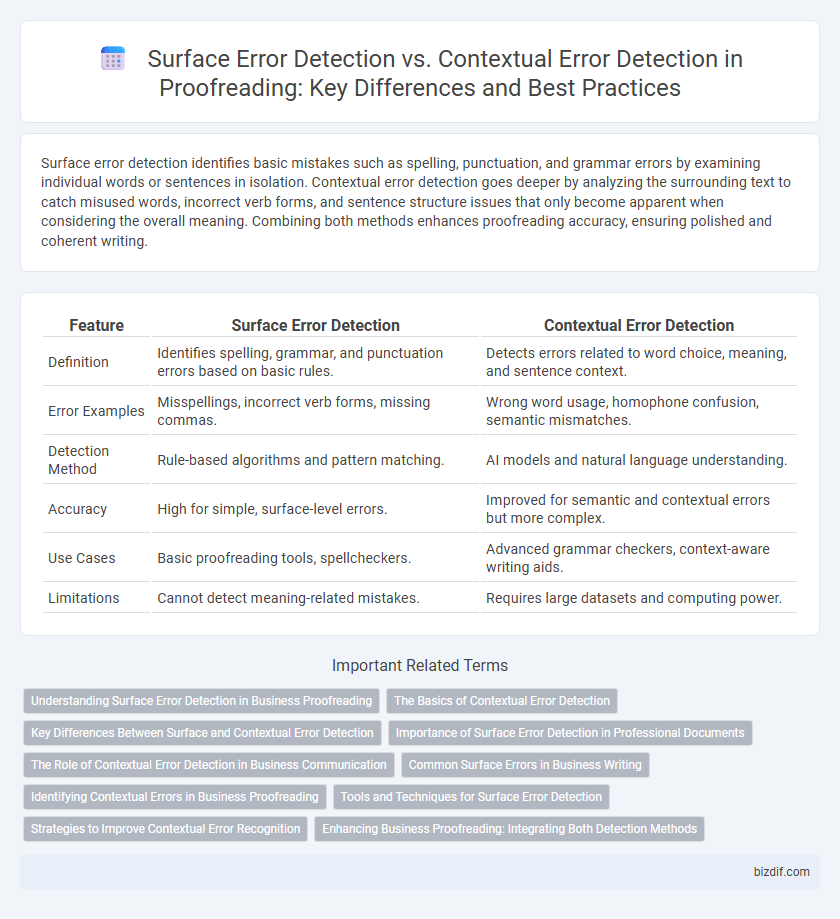Surface error detection identifies basic mistakes such as spelling, punctuation, and grammar errors by examining individual words or sentences in isolation. Contextual error detection goes deeper by analyzing the surrounding text to catch misused words, incorrect verb forms, and sentence structure issues that only become apparent when considering the overall meaning. Combining both methods enhances proofreading accuracy, ensuring polished and coherent writing.
Table of Comparison
| Feature | Surface Error Detection | Contextual Error Detection |
|---|---|---|
| Definition | Identifies spelling, grammar, and punctuation errors based on basic rules. | Detects errors related to word choice, meaning, and sentence context. |
| Error Examples | Misspellings, incorrect verb forms, missing commas. | Wrong word usage, homophone confusion, semantic mismatches. |
| Detection Method | Rule-based algorithms and pattern matching. | AI models and natural language understanding. |
| Accuracy | High for simple, surface-level errors. | Improved for semantic and contextual errors but more complex. |
| Use Cases | Basic proofreading tools, spellcheckers. | Advanced grammar checkers, context-aware writing aids. |
| Limitations | Cannot detect meaning-related mistakes. | Requires large datasets and computing power. |
Understanding Surface Error Detection in Business Proofreading
Surface error detection in business proofreading targets obvious mistakes such as typos, spelling errors, punctuation slips, and grammatical inaccuracies that disrupt the text's clarity. This type of error detection is crucial for maintaining professionalism and ensuring documents meet standard language conventions. Effective surface error detection reduces miscommunication risks and enhances the overall credibility of business communications.
The Basics of Contextual Error Detection
Contextual error detection identifies mistakes by analyzing the relationship between words in a sentence, unlike surface error detection which only spots spelling or grammatical errors based on fixed rules. It uses natural language processing models to understand syntax and semantics, enabling it to catch errors like incorrect word choices and homophones that surface methods miss. This approach improves accuracy in proofreading by considering the context, making it essential for advanced grammar checking tools.
Key Differences Between Surface and Contextual Error Detection
Surface error detection identifies spelling mistakes, punctuation errors, and grammatical inaccuracies based on fixed rules and dictionaries. Contextual error detection evaluates word usage and sentence meaning to spot misused words, homophones, and semantic inconsistencies that surface detection often misses. Key differences include surface detection's focus on form versus contextual detection's emphasis on meaning and context within the text.
Importance of Surface Error Detection in Professional Documents
Surface error detection plays a critical role in professional documents by identifying spelling, punctuation, and grammatical mistakes that could undermine the document's credibility. Accurate detection of these surface errors ensures clarity and upholds the writer's professionalism, which is essential in formal communication and business settings. Unlike contextual error detection, which focuses on meaning and usage, surface error detection enhances the document's overall readability and prevents misinterpretation caused by technical inaccuracies.
The Role of Contextual Error Detection in Business Communication
Contextual error detection plays a crucial role in business communication by identifying mistakes that surface error detection often misses, such as word misuse and tone inconsistencies. It leverages semantic analysis and natural language processing to ensure messages convey the intended meaning accurately, preserving professionalism and clarity. Effective contextual error detection reduces misunderstandings and enhances the credibility of business correspondence, ultimately supporting better decision-making and stakeholder relationships.
Common Surface Errors in Business Writing
Common surface errors in business writing include spelling mistakes, punctuation errors, and typographical slips that are easily detected by spellcheckers and proofreading tools. Surface error detection focuses on correcting these tangible issues to improve clarity and professionalism. Contextual error detection, by contrast, addresses misused words and grammar mistakes that require understanding the sentence meaning, such as confusing "their" and "there" or incorrect verb tense in business reports.
Identifying Contextual Errors in Business Proofreading
Contextual error detection in business proofreading focuses on identifying mistakes that affect the meaning and appropriateness of the text within its specific business context, such as incorrect terminology, inconsistent tone, or misused phrases. Unlike surface error detection, which targets spelling, grammar, and punctuation mistakes, contextual error detection ensures that the language aligns with the intended professional message and audience expectations. Advanced proofreading tools and expert reviewers use semantic analysis and industry knowledge to accurately spot contextual errors that could undermine credibility or cause miscommunication in business documents.
Tools and Techniques for Surface Error Detection
Surface error detection tools primarily rely on rule-based algorithms and pattern matching techniques to identify spelling mistakes, punctuation errors, and basic grammatical issues in text. Popular tools such as Grammarly and Ginger implement these methods to highlight surface-level errors by comparing text against predefined linguistic rules and error databases. These tools often integrate dictionaries, regular expressions, and morphological analysis for effective detection and correction of surface errors in writing.
Strategies to Improve Contextual Error Recognition
Surface error detection relies on identifying obvious spelling and grammatical mistakes by matching input against predefined rules or dictionaries, while contextual error detection requires understanding the sentence meaning and grammar within its broader usage. Strategies to improve contextual error recognition include leveraging advanced natural language processing models like transformers, incorporating semantic analysis techniques, and using large annotated corpora to train systems on diverse real-world contexts. Enhancing contextual error detection accuracy also involves integrating syntactic parsing and word sense disambiguation to better capture subtle errors in meaning and usage.
Enhancing Business Proofreading: Integrating Both Detection Methods
Integrating surface error detection and contextual error detection significantly enhances business proofreading by ensuring both spelling and grammatical accuracy alongside semantic relevance. Surface error detection identifies typographical mistakes and punctuation errors, while contextual error detection evaluates word usage and sentence structure to maintain clarity and professionalism. Combining these methods reduces costly miscommunications and fosters a polished, credible brand image in corporate communications.
Surface error detection vs Contextual error detection Infographic

 bizdif.com
bizdif.com